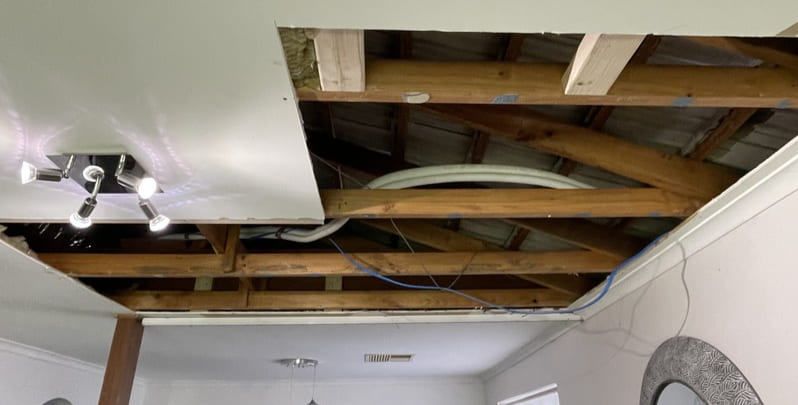There's something universally soothing about the sound of rain. It can be incredibly calming, especially when you're drifting off to sleep. However, while rain may be therapeutic, it can sometimes wreak havoc on your roof. No one wants to wake up to a leaking roof after a heavy downpour. A leaking roof can quickly escalate into a major issue, causing water stains on walls and ceilings, mold growth, and even structural damage to your property. Even though winter has passed, heavy rainfall isn't limited to just those months. There are several telltale signs that your roof might be leaking, and taking action early can prevent bigger problems down the line. The good news is that identifying a roof leak early and addressing it promptly can save you a lot of trouble. Let's explore how to spot a leaking roof and what steps you can take to ensure your roof stays in great shape. One of the most common indicators of a leaking roof is the appearance of mold or mildew. If you notice any lingering stains or discoloration on your ceiling or walls, it could be a sign of water intrusion. Left untreated, these stains can worsen over time and turn into dripping water, causing extensive damage. On the exterior of your home, moss or algae growth along the walls or roofline might suggest moisture issues. While some people might find this aesthetically pleasing, it’s actually a warning sign of excessive moisture and can lead to more serious problems if ignored. Roof leaks can stem from a variety of factors. Some of the most frequent culprits include: Leaves, debris, and small holes can worsen existing roof problems, potentially leading to leaks over time. Early intervention with a professional roofer can help prevent these issues from escalating. In the event of a leaking roof, immediate action is critical to minimize damage. Start by relocating any furniture or electronics from the affected area to protect them from water damage. If it’s safe to do so, inspect your attic or ceiling cavity to get a better understanding of the extent of the leak. Minor leaks may not require immediate professional assistance. A temporary fix, such as applying roofing cement with a putty knife, might suffice for now. However, remember that these are only short-term solutions. For a permanent fix, consulting a professional roofing company is essential. Heavy rain can exploit existing vulnerabilities in your roof, amplifying weak spots and causing leaks. Pay close attention to areas like flashing, vent boots, and step flashing, as these are common entry points for water in leaky roofs. On tile roofs, broken tiles or compromised ridge capping can allow rainwater to infiltrate. For metal roofs, ensuring all screw holes are sealed and sheets are installed correctly is crucial. Regular inspections, particularly after heavy rains, can help preemptively address potential issues. Prevention is always better than cure when it comes to roof leaks. Taking proactive measures can save you both time and money in the long run. The simplest step is to regularly clean your gutters. Removing leaves and debris ensures proper water flow and prevents future headaches. Installing gutter guards can also help if you live in an area surrounded by trees. While a DIY approach can offer temporary relief, it’s not a substitute for professional expertise. Companies like Metropolitan Plumbing specialize in roof leaks, repairs, and plumbing services. Their technicians can provide comprehensive inspections and lasting solutions, ensuring your roof remains in excellent condition. When repairing a leaky roof, the quality of materials used makes all the difference. For tiled roofs, match your existing tiles with concrete or clay tiles that suit your climate. For metal roofs, choosing the correct type of metal and ensuring proper coating is vital for weather resistance. Flat roofs might benefit from materials like EPDM or TPO, known for their durability and ability to seal effectively against water. Always opt for high-quality materials that can withstand the elements and provide long-term protection against leaks. Scheduling a full roof inspection with a professional roofing company is a smart move if you’re looking for comprehensive solutions. Experts can identify and repair issues like damaged shingles, insufficient roof sheathing, and improper roof penetrations. If your roof has seen better days, consider discussing replacement options with your insurance provider. In the meantime, keeping gutters free of debris and ensuring downpipes are unblocked can help mitigate immediate risks. Addressing small leaks early can prevent them from turning into major problems requiring costly repairs or replacements. What happens when a sudden roof leak turns your dining room into a makeshift swimming pool? Immediate action is key. At Metropolitan Plumbing, we’re available 24/7 to send a plumber to your location within an hour of your call. With flexible financing options available to eligible customers, you won’t have to worry about upfront costs. In the meantime, place a bucket beneath the leak to collect water and surround the area with towels to absorb any spills. Remember, this information is intended for guidance only. Always consult local regulations or professionals before undertaking any repairs. Stay ahead of potential issues by keeping your roof in top shape. Prevention truly is the best policy! TPU Material Wire And Cable Sleeving Tpu Material Wire And Cable Sleeving,Wire Tpu Polyurethane,Wire Cable Polyurethane Resin,Polyester/Polyether Base Tpu Resin Xuchuan Chemical , https://www.xctpu.comSigns Your Roof is Leaking
Common Causes of Roof Leaks
What to Do if Your Roof is Leaking
Heavy Rain and Its Impact on Roof Leaks

Preventing Roof Leaks
Selecting the Right Materials for Repairs
Long-Term Solutions for Roof Leaks
Emergency Roof Leak Response
How Can You Fix a Leaking Roof?
Next Article
Safety First
Prev Article
How Can You Fix a Leaking Roof?